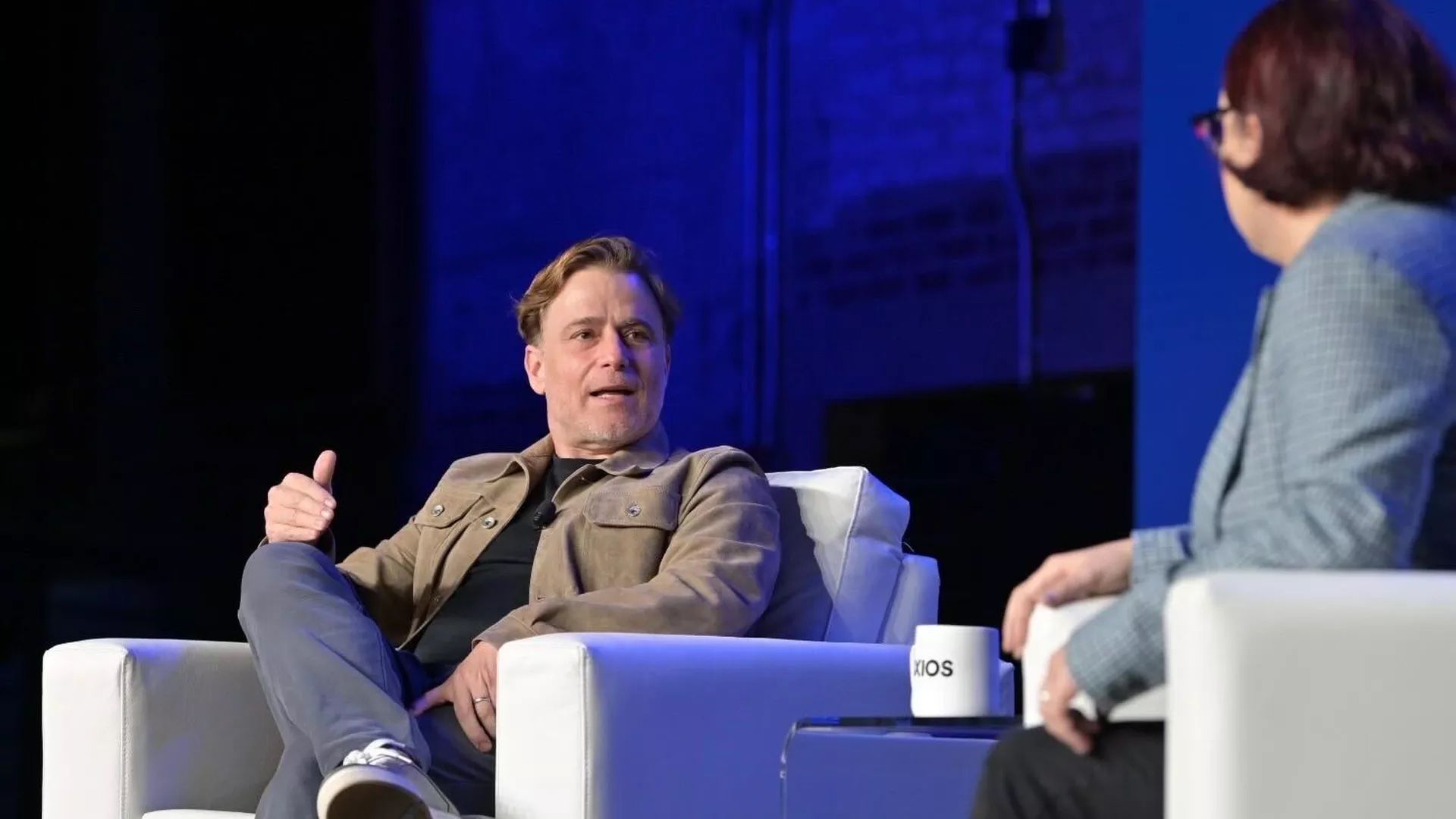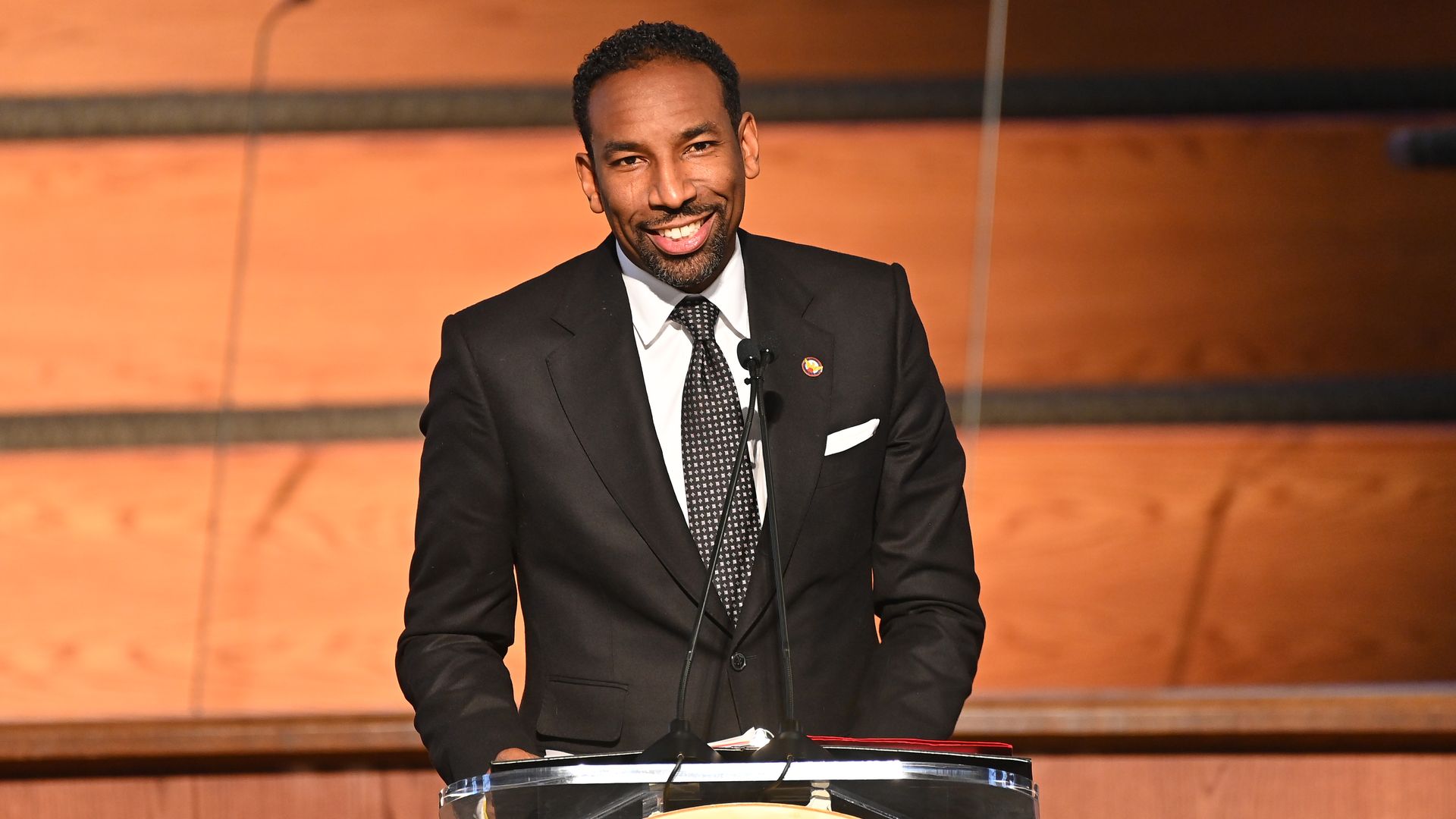| | | | | | | Presented By PwC | | | | Axios What's Next | | By Jennifer A. Kingson and Joann Muller · Apr 07, 2022 | | Hello, and welcome to Thursday! - Did you know that Axios just launched a newsletter all about crypto? Check it out here and subscribe here.
🚨 Join Axios national political correspondent Jonathan Swan today at 8:30 a.m. ET for an exclusive interview with Senate Republican Leader Mitch McConnell. Register here to attend in person or virtually. Today's Smart Brevity count: 1,249 words ... 4.5 minutes. | | | | | | 1 big thing: Even Slack's CEO is still figuring out hybrid work |  | | | Slack's CEO, Stewart Butterfield, spoke at the Axios What's Next Summit this week. Photo: Joy Asico | | | | Stewart Butterfield, the CEO of Slack — the messaging tool that became a pillar of interoffice communication during the pandemic — finds the post-COVID world of hybrid work as tricky to master as anyone else, writes Scott Rosenberg, Axios' managing editor for technology. Why it matters: Butterfield, who spoke at the Axios What's Next Summit this week, says each company and each employee makes different calculations about what kind of work environment they want now. - "A lot of people who are fresh out of college have a much higher desire to get back to the office — it's the basis of their social life," Butterfield said.
- "And then there's people like me, who have an 11 1/2-month-old. There's no 'time to get the last train to get home before he goes to sleep' or anything like that — in fact, between calls I can go downstairs and play with him."
- But a general yearning for flexibility gives "the distributed model a little bit of an upper hand," he adds.
The shift to remote work certainly transformed Slack. - "Two-thirds of our employees have been hired post-pandemic," Butterfield says. "We did an $800M convertible bond offering and then this whole acquisition [by Salesforce] happened with no meeting in person at all. But now it just seems normal."
As companies partially reopen their workplaces, Butterfield foresees a need for new, more flexible kinds of office designs. - In the hybrid-work-era office, the least valuable use of space is providing employees with spots to work alone on their laptops, he says.
- But places to bring recruits, host customers and "project power," as well as meeting rooms, training program spaces and places to eat will remain important.
More work-from-home will mean that homes have to change too. - "If we were all going to work from home, we wouldn't have built or designed our houses the same way," Butterfield says.
Read the full story. |     | | | | | | 2. A helium shortage for weather balloons |  | | | Illustration: Aïda Amer/Axios | | | | Just as the spring tornado season kicks into high gear, the National Weather Service is facing shortages in key gases it uses to fill weather balloons, Andrew Freedman writes in Axios Generate. Why it matters: Weather balloons are usually launched twice daily at about 100 locations nationwide and provide vital information for weather forecasting, from the temperature profile of the atmosphere to the winds aloft. They can help anticipate severe thunderstorms, for example. - But several balloon sites have had to limit launches because of supply chain shortages of helium, plus a contract dispute concerning a supplier of hydrogen gas.
Context: With extreme weather events on the rise both in number and severity, due in part to human-caused climate change, America's weather forecasting infrastructure is showing signs of strain. Driving the news: On March 29 the NWS sent a bulletin announcing the reduction in frequency of weather balloon launches due to a "global supply chain disruption of helium" and a "temporary issue with the contract" of a hydrogen supplier. (Most NWS weather balloons use hydrogen rather than helium.) - According to the notice, about 9% of the 101 upper air observation sites were affected by the gas shortage and contract problem, with more disruptions expected.
Read the full story. |     | | | | | | 3. Zoos across U.S. scramble to prevent bird flu outbreak |  | | | Flamingos at the Los Angeles Zoo. Photo: Valerie Macon/AFP via Getty Images | | | | Zoos across the country are taking precautions to protect their bird populations against a recent bird flu outbreak, with some even closing their bird exhibits to the public, Axios' Ivana Saric writes. Why it matters: In less than two months, at least 24 states have reported bird flu cases, and nearly 23 million birds have been killed to limit the spread of the virus, making this the worst bird flu outbreak since 2015, NPR reported. - A USDA map of infections of the highly pathogenic avian influenza (HPAI) among wild birds shows that cases are concentrated along the eastern coast and the Midwest.
- The bird flu typically spreads through the nasal discharge or droppings of wild birds, which can contaminate dust and soil.
- However, it can also spread through contaminated equipment, vehicles, boots and clothing, AP reported.
- While bird flu infections often prove deadly to birds, infections among people are rare.
The bottom line: No outbreaks of the bird flu have been detected in zoos yet, but dead wild birds found in or near zoos were infected. Share this story. |     | | | | | | A message from PwC | | Transparency is key in creating trust | | |  | | | | We are bringing the strength of our people, capabilities and technology together to support our clients in building trust and delivering sustained outcomes What you need to know: In the past year, we have evolved into a community of solvers coming together in unexpected ways. See how. | | | | | | 4. Would your avatar like virtual fries with that? |  | | | An image from the Wendyverse, a virtual reality platform operated by the restaurant chain. Image courtesy of Wendy's | | | | Restaurant chains like Wendy's and Chipotle are dabbling in the metaverse, putting up virtual worlds where consumers can play games but can't order food, the Wall Street Journal reports. Why it matters: Companies are gingerly pinning their corporate hopes on the consumer adoption of the metaverse, a digital space where people can play and socialize in 3D while wearing virtual reality goggles. But it's not clear if this will take off. - Only 22% of Gen Z respondents to an Axios-Momentive poll — which surveyed 2,553 adults online from March 23-25 — said they were excited about the metaverse.
- Older respondents gave an even more resounding "meh."
Driving the news: Wendy's just opened "a virtual restaurant in Horizon Worlds, the virtual reality game from Meta," formerly known as Facebook, the WSJ reports. "Visitors cannot buy food there, virtual or otherwise, but they can play a basketball-themed game located near the restaurant." - Chipotle is introducing a game and virtual restaurant in Roblox, per the Journal. "Up to 100,000 players who successfully roll a virtual burrito in the game will earn "Burrito Bucks," good for real food at Chipotle restaurants."
- Coca-Cola is using the metaverse to introduce a new product — Coca-Cola Zero Sugar Byte — the New York Post reports.
- "It remains unclear what the beverage tastes like, though Coca-Cola describes it as 'transcending the digital and physical worlds.'"
|     | | | | | | 5. The nation's most stylish mayors |  | | | Mayor Andre Dickens of Atlanta attends a 2022 Martin Luther King Day observance. Photo: Paras Griffin/Getty Images | | | | A ribbon-cutting, a press conference, a meeting with enraged constituents — there are just so many places a mayor might want to look their best, Jennifer A. Kingson writes. That's why Route Fifty, a news website for state and local government leaders, decided to publish a list of the nation's 10 most fashionable mayors, based on the results of a reader survey and "input from expert fashion judges." They are, in alphabetical order: - Eric Adams of New York. "He is often seen donning classic suits, but sported a chic look at New York Fashion Week this year, wearing a blue coat with an eye-catching paisley pattern," Route Fifty noted.
- Justin Bibb of Cleveland. His "laid-back but refined millennial sensibilities come across in his style — from hoodies and bomber jackets to suits."
- London Breed of San Francisco. "Even during her standard daily duties, Breed always manages to wear chic clothing that can stand out in a crowd."
- LaToya Cantrell of New Orleans. "For this year's Mardi Gras, Cantrell shined with a red sparkly jumpsuit that could get anyone in a festive mood."
- Andre Dickens of Atlanta. "From plaid to stripes to classic black, grays and navy blues," he "may have the largest collection of suits of all the nominees."
- Jacob Frey of Minneapolis. "Overall, Frey's style might be summed up as 'Midwest chic.'"
- Tishaura Jones of St. Louis. Her style is "classy, modern [and] professional," with "jaw-dropping outfits."
- Mattie Parker of Fort Worth, Texas. Her "funky fresh cowgirl look" often "consists of brightly colored outfits."
- Regina Romero of Tucson. "Even when digging a hole on a construction site," she "manages to be one of the best dressed at the event, with a fiery red jacket complementing classic black pants."
- Michelle Wu of Boston. Wu favors "darker colors such as blacks and blues," and dazzled in a "forest green dress ... accented perfectly by the flash of a silver necklace."
|     | | | | | | A message from PwC | | The key to trust: transparency | | |  | | | | Our community of solvers remains committed to building a culture of belonging. Looking ahead: We are doubling down on our commitment to build trust, with a sharpened focus on supporting underrepresented communities, while advancing progress in our firm. Learn more. | | | | Was this email forwarded to you? Get your daily dose of What's Next magic by signing up for our free newsletter here. |  | It's called Smart Brevity®. Over 200 orgs use it — in a tool called Axios HQ — to drive productivity with clearer workplace communications. | | | | | | Axios thanks our partners for supporting our newsletters. If you're interested in advertising, learn more here.
Sponsorship has no influence on editorial content. Axios, 3100 Clarendon Blvd, Suite 1300, Arlington VA 22201 | | | You received this email because you signed up for newsletters from Axios.
Change your preferences or unsubscribe here. | | | Was this email forwarded to you?
Sign up now to get Axios in your inbox. | | | | Follow Axios on social media:    | | | | | |










No comments:
Post a Comment